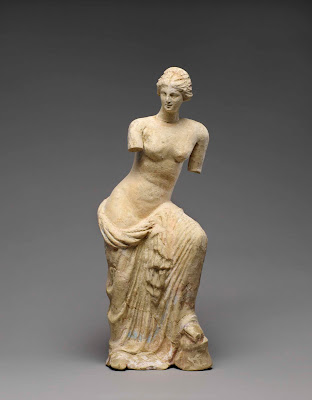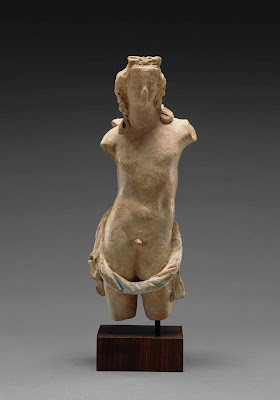 |
| Aphrodite kneeling in a seashell 300-275 BC Greek terracotta statuette Louvre, Paris |
"Aphrodite was also worshiped by prostitutes. Epithets such as Hetaira ('courtesan') and Porne ('prostitute') show her as protectress of this profession, whose essential stock-in-trade was seduction. Corinth was particularly well known for the beauty and luxurious living of its prostitutes, who certainly revered the local Aphrodite. All the same it is unlikely that her sanctuary on Acrocorinth was the location of an institutionalized form of what is usually called 'sacred prostitution'. The only source for such a remarkable practice in a Greek context, Strabo, places it in a vague past time, and is surely influenced by the eastern practices with which he was familiar. Herodotus also mentions a similar practice in several parts of the Mediterranean area, and his silence in regard to Corinth should invite caution."
– André Motte, writing in the Oxford Classical Dictionary, 3rd edition, edited by Simon Hornblower and Antony Spawforth (Oxford, 1996)
 |
| Aphrodite leaning on a pillar 3rd century BC Greek terracotta statuette Louvre, Paris |
 |
| Statuette of Aphrodite 300-200 BC Greek terracotta from South Italy Getty Museum, Los Angeles |
 |
| Warrior falling from galloping horse 4th-3rd century BC Greek terracotta statuette Louvre, Paris |
 |
| Statuette of Apollo 200-100 BC Greek terracotta from South Italy Getty Museum, Los Angeles |
 |
| Woman playing knucklebones 4th century BC Greek terracotta statuette Louvre, Paris |
 |
| Woman playing knucklebones 4th century BC Greek terracotta statuette Louvre, Paris |
 |
| Actor wearing ass's head and playing the cithara 1st century BC Greek terracotta statuette Louvre, Paris |
 |
| Actor dressed as a woman 325-225 BC Greek terracotta statuette Louvre, Paris |
 |
| Statuette of a mime 225-275 BC Greek terracotta from South Italy Getty Museum, Los Angeles |
 |
| Statuette of Eros 200-100 BC Greek terracotta from South Italy Getty Museum, Los Angeles |
 |
| Statuette of a woman dancing 400-200 BC Greek terracotta from South Italy Getty Museum, Los Angeles |
 |
| Statuette of a woman mourning 300-250 BC Greek terracotta from South Italy Getty Museum, Los Angeles |
 |
| Statuettes of women mourning 325 BC Greek terracotta from South Italy Getty Museum, Los Angeles |
 |
| Sculptural group Seated poet and Sirens 350-300 BC Greek terracotta from South Italy Getty Museum, Los Angeles |
"A seated man is flanked by sirens, creatures part bird and part woman, in this nearly life-size terracotta group. In Greek mythology, the singing of the sirens lured sailors to their deaths; thus the creatures have general funerary connotations. The seated man is also a singer, as shown by his open mouth and the pick (plektron) with which he plays his now-missing lyre, once cradled in his left arm. His precise identity, however, is uncertain. He might be Orpheus, who was famous for his singing and who traveled to the land of the dead and was able to return. But in art of this period, Orpheus is usually shown wearing a specific Eastern costume not seen here. Therefore, this man may just be an ordinary mortal, perhaps the deceased, in the guise of a poet or singer."
– from curator's notes at the Getty Museum